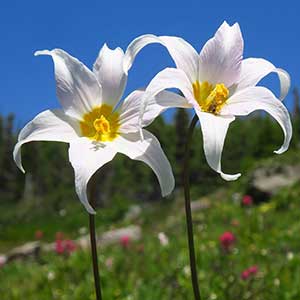Erythronium montanum
Erythronium multiscapideum
avalanche-lily, white avalanche-lily, white glacier lily
Sierra fawn-lily, Sierra foothills fawn-lily
narrowly ovoid, 25–60 mm.
ovoid, 20–50 mm, producing bulbels (usually 1–3 per parent bulb) at ends of long, slender stolons.
10–20 cm;
blade green, ovate to broadly lanceolate, base ± abruptly narrowed to petiole, margins wavy.
4–16 cm;
blade mottled with irregular streaks of brown or white, ± lanceolate, margins entire to wavy.
12–35 cm.
8–23 cm, branching just above leaves near ground level when flowers more than 1.
1–3-flowered.
1–4-flowered.
tepals white to creamy white with bright yellow zone at base, broadly ovate to broadly lanceolate, 25–45 mm, inner wider than outer, auriculate at base, length less than 4 times width;
stamens 12–24 mm;
filaments white, linear, slender, less than 0.8 mm wide;
anthers bright yellow;
style white, 13–25 mm;
stigma with slender, usually recurved lobes 1–5 mm.
flowering individuals generally uncommon in populations, most plants 1-leaved and vegetative;
tepals white to cream with yellow base, broadly lanceolate to elliptic, 16–40 mm, inner with small auricles at base;
stamens 10–15 mm;
filaments white, linear, slender, less than 0.8 mm wide;
anthers white to cream;
style white, 10–13 mm;
stigma unlobed or with recurved lobes 1–4 mm.
oblong, 3–6 cm.
obovoid, 2–5 cm.
= 24.
= 24.
Erythronium montanum
Erythronium multiscapideum
This species occurs in the Coast Ranges of southern British Columbia, and disjunctly to southern Vancouver Island, the Olympic Peninsula, and Cascade Mountains from Mount Rainier National Park in Washington to central Oregon.
(Discussion copyrighted by Flora of North America; reprinted with permission.)
Erythronium multiscapideum is unusual among western species (and resembles some eastern species) in its tendency to reproduce vegetatively through the production of bulbels at the ends of stolons. It is similar in many respects to E. californicum and sometimes intergrades with it, resulting in occasional populations with the bulb characteristics of one species and the inflorescence branching pattern of the other.
(Discussion copyrighted by Flora of North America; reprinted with permission.)
- Local floras:
CA,
OR
- Local Web sites:
CalFlora,
CalPhotos,
Flora NW,
PNW Herbaria
WildflowerSearch
iNaturalist (observations)
- LBJ Wildflower Center
- SEINet
- Plants of the World Online
- Encyclopedia of Life
- Wikipedia
- Google Image Search


